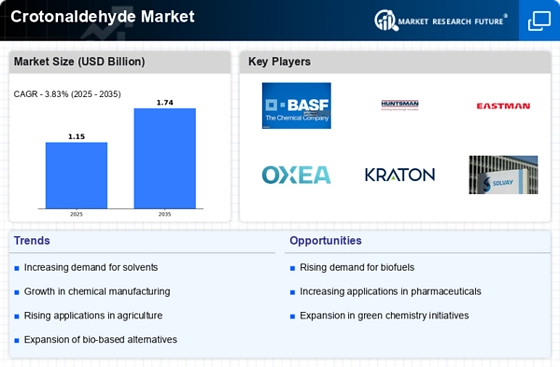Growth in the Automotive Sector
The Crotonaldehyde Market is likely to benefit from the growth in the automotive sector, where crotonaldehyde is used in the production of various automotive components. Its properties make it suitable for applications in adhesives, coatings, and sealants, which are essential for vehicle manufacturing. As the automotive industry shifts towards more sustainable practices, the demand for high-performance materials is expected to rise. Data suggests that the automotive adhesives market is projected to grow at a CAGR of 6% over the next few years, which may positively impact the Crotonaldehyde Market as manufacturers seek reliable and efficient materials.
Rising Demand in Chemical Synthesis
The Crotonaldehyde Market is experiencing a notable increase in demand due to its essential role in chemical synthesis. This compound serves as a precursor for various chemicals, including butyraldehyde and crotonic acid, which are integral in the production of plastics, resins, and pharmaceuticals. As industries seek to enhance production efficiency, the reliance on crotonaldehyde is likely to grow. Recent data indicates that the market for butyraldehyde, a derivative of crotonaldehyde, is projected to expand at a compound annual growth rate of approximately 4.5% over the next five years. This trend suggests a robust future for the Crotonaldehyde Market, driven by the increasing need for versatile chemical intermediates.
Expansion in Agrochemical Applications
The Crotonaldehyde Market is witnessing a surge in its application within the agrochemical sector. Crotonaldehyde is utilized in the synthesis of various agrochemicals, including herbicides and insecticides, which are crucial for modern agricultural practices. As the global population continues to rise, the demand for food production intensifies, thereby increasing the need for effective agrochemical solutions. Reports indicate that the agrochemical market is expected to grow at a rate of around 5% annually, which could significantly bolster the Crotonaldehyde Market. This expansion is indicative of a broader trend towards enhancing agricultural productivity through innovative chemical solutions.
Technological Innovations in Production
The Crotonaldehyde Market is poised for growth due to ongoing technological innovations in its production processes. Advances in catalytic processes and reaction conditions are enhancing the efficiency and yield of crotonaldehyde synthesis. These innovations not only reduce production costs but also minimize waste, making the process more environmentally friendly. Recent studies indicate that improved production technologies could lead to a 10% reduction in costs, thereby making crotonaldehyde more accessible to various industries. This trend indicates a promising future for the Crotonaldehyde Market as it adapts to technological advancements and market demands.
Increasing Focus on Sustainable Practices
The Crotonaldehyde Market is influenced by the growing emphasis on sustainable production practices. Manufacturers are increasingly adopting eco-friendly methods to produce crotonaldehyde, aligning with global sustainability goals. This shift not only reduces environmental impact but also meets the rising consumer demand for sustainable products. The market for sustainable chemicals is anticipated to grow significantly, with projections indicating a potential increase of 8% annually. This trend suggests that the Crotonaldehyde Market could see enhanced opportunities as companies innovate to meet sustainability standards while maintaining product efficacy.

















Leave a Comment